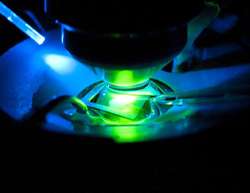At the forefront of optogenetics

(Medical Xpress) -- In the last couple of years scientists from the Friedrich Miescher Institute for Biomedical Research have developed new strategies to stimulate individual brain cells with light. Optogenetic technologies were named "Method of the Year" by the leading scientific journal Nature Methods in 2010. FMI scientists not only apply this to meet their biomedical needs but refine the tool as well. A recent publication in PNAS is further testimony to this distinctive expertise at the FMI.
Untangling the networks of neurons in the brain that control sensory impressions, learning and memory is a daunting task. For many years research efforts addressing the biological basis of mental diseases such as anxiety disorders or dementia led to disappointing results, because existing technologies were simply too imprecise. It is therefore no surprise that a new technology called optogenetics has captured the imagination of many in this field, and in particular neuroscientists at the Friedrich Miescher Institute for Biomedical Research of the Novartis Research Foundation.
Using optogenetic tools, FMI scientists are now able to activate defined neurons selectively, rapidly and reversibly by a short pulse of light. A protein borrowed from an algae - Channelrhodopsin 2 (ChR2) - is at the core of this new technology. This protein is an ion channel that opens upon a light stimulus and rapidly discharges the membrane potential of excitable cells. In neurons, this equals activation. By introducing ChR2 into subsets of neurons, scientists are now able to study their function with high precision.
In action for biomedical research
Andreas Lüthi has pioneered the application of this method together with Thomas Oertner, Rainer Friedrich and Botond Roska at the FMI. Lüthi is interested in the cellular mechanisms controlling fear and its extinction. "The inability to control or inhibit inappropriate fear responses is a hallmark of anxiety disorders. Optogenetics has allowed us in the past two years to identify neuronal circuits responsible for fear processing and to improve our understanding of the neurobiological basis of anxiety disorders," comments Lüthi. The same is true for Rainer Friedrich's studies of neuronal circuits in the olfactory system and forebrain. "Optogenetics opens new avenues for us to understand how neuronal circuits process odour information," comments Friedrich, "by taking optogenetics to the single-cell level, we can analyze the functions of specific cells during information processing in the intact brain. This is leading to a novel understanding of fundamental neuronal computations and their contributions to behavior."
Botond Roska takes optogenetics even one step further. He is interested in how neurons interact in local neuronal networks namely the retina. He and his team use optogenetics to genetically identify cell types and stimulate them specifically. Moreover, he has devised an optogenetic method to restore vision in mice suffering from retinal degeneration. "Introducing a light-sensitive archaebacterial protein into the remaining but non-functional cone cells of the retina not only reactivates the cone cells' ability to interact with the rest of the visual system, it also prompts sophisticated visually guided behavior," comments Roska.
Improving optogenetics
While these innovative findings already illustrate the power of this new method, some of the natural traits of ChR2 are not optimal for applications in neuroscience. Thomas Oertner and his team at the FMI worked together with biophysicists at the Humboldt University in Berlin to create a novel ChR2 variant with improved properties, called ET/TC. "We wanted to identify a ChR2 mutant that reacts fast and strongly to small amounts of light. In the past, mutants either exhibited one feature or the other," comments Oertner. The ET/TC variant is the first to combine both: It activates neurons fast with high fidelity and across a wide range of light intensities. Their results have just been published in the Proceedings of the National Academy of Science (May 2011).
Optogenetics, however, is not restricted to electrical activation of cells: Earlier this year, Oertner's group has demonstrated the power of a light-sensitive bacterial enzyme to control cAMP levels in neurons. As a consequence, scientists can not only interfere with the communication between neurons in the brain, but also directly stimulate intracellular signalling cascades that regulate the strength of synaptic connections. As it is customary in the basic research community, these new tools are freely shared with laboratories around the world.
More information:
High-efficiency channelrhodopsins for fast neuronal stimulation at low light levels. PNAS 2011
Light Modulation of Cellular cAMP by bPAC, JBC 2011


















